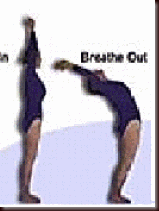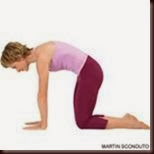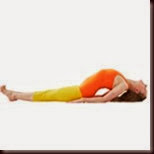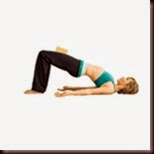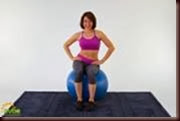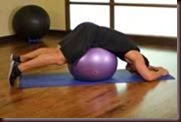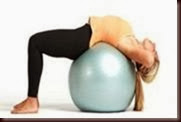I posted this earlier today but somehow the formatting didn’t transfer very well and I ended up with a mess and half of the pages missing.
This is my warm-up and cool down routine that I use prior to and after my workout. This is also a great place to start when you first get out of bed to loosen your joints/ muscles.
Some people have benefited from having a yoga block (hard foam block) to start out with yoga poses until they are flexible enough to reach the ground.
Be aware of your body. Do not force the poses. Maintaining balance is key to any workout. Don’t be discouraged if you cannot do the whole routine. As I have said, this is the routine I use and your needs may be different from mine.
I do 5-10 reps for each pose before beginning my workout routine. Hold each pose for 15-30 seconds while maintaining normal breathing.
*** Please note these are not my pictures. Most of the pictures shown below come from http://www.yogajournal.com which is a great website you can use to track your progress and also has sequence builder you may use to build your own routine around your needs. ****
Another great website to check out if you want more info for each pose is http://www.abc-of-yoga.com
| Mountain Pose: Stand tall with your feet together and arms by your side. If you have a hard time balancing with your feet together, widen your stance a few inches so that your feet are hip width apart. As you breathe in, bring in your belly button and lift your chest. Stretch your toes out to find your center. You may also want to rock back and forth between your heel and balls of your feet until you find a comfortable balance. | |
| Back Bend: From Mountain Pose, as you breathe in, slowly lift your arms upwards. Interlace your fingers above your head. On exhale, slowly bend your back and stretch backwards bringing your arms behind you. Bring your body back to mountain pose as your inhale. Remember to keep your legs firmly planted and your body centered to maintain balance in this position. | |
| Forward Bend: From Mountain Pose, breathe in while slowly lifting your arms upwards above your head. As you exhale, bend from your hips and stretch forward placing your hands on the ground. If you find this difficult, you can put your hands on your thighs or bend as far as you feel comfortable with. Return to Mountain Pose as you inhale. As you become more comfortable in this pose, walk your hands inwards towards your feet until your hands are resting beside your feet. Remember to keep your legs straight and center your body. | |
| Wide Legged Forward Bend: From Mountain Pose, spread your legs wide and inhale. As you exhale, bend forward and place your hands on the floor in front of you. As you get comfortable with this pose, walk your hands inwards towards your body until your head and hands are centered between your legs. Keep your legs straight and balance your weight on your feet. Bring your body upright as you inhale. | |
| High Lunge: From the Forward Bend Pose, turn your body slightly to the left so that you’re facing the left leg and your left foot is pointed outwards. Your right foot will be strong behind you with your toes facing forward. Inhale. As you exhale, push your torso forward so that it is aligned with your left knee and your hands are touching the ground on either side of your left foot. If you have difficulty with this pose, you may place your hands on your left knee instead of the floor. You should feel both of your legs stretching and keep your body centered and elongated. Inhale, bring your body back to a wide leg stance, swivel your body and repeat on the right side. | |
| Low Lunge: From High Lunge Pose,(inhale) bring your back leg to the floor from knee down. Point your right foot forward and your left foot should be pointing outward behind you. As you exhale, bring your arms upward, and lean into your right leg. Inhale, bring your body back into a wide leg stance, swivel on your heels and repeat for the left side. | |
| Plank Pose: Turn your body so that you are on your knees with your arms directly under your shoulders. Spread your fingers for better balance. Tuck your toes and step back with your feet so that your body is in a straight line. As you inhale, pull in your pelvic muscles towards your spine. Relax those muscles as you exhale. | |
| Downward Facing Dog: From Plank Pose, (inhale) walk your hands backwards and bring your hips/ butt upwards so that your body forms an upside down V. Bring your abdomen in towards your spine and elongate your body stretching upwards as you exhale. | |
| Child’s Pose: From Downward Facing Dog Pose, bring your knees in to touch the floor. With your torso tall and upright, inhale. As you exhale bend your torso forward to rest upon your knees with your head down and arms on either side of your legs. | |
| Cobra Pose: From Child’s Pose, bring your body forward so that your stomach is on the floor and your legs are straight and the tops of your feet are on the floor. On inhale, pressing your thighs into the floor and bringing your elbows in towards your body, push up with your arms and bring your torso up off of the floor. | |
| Cow | Cow Pose & Cat Pose From Cobra Position, bring your arms perpendicular to your shoulders and rock your body back onto your knees with your upper body perpendicular to the floor (also known as Table Top Pose). As you inhale, lift your chest and buttocks towards the ceiling allowing your stomach push down slightly to the floor. Return to Table Top Pose. From Table Top Pose, tuck your head and chest so that your head is pointed downwards. As you exhale, round your spine and bring your spine upwards towards the ceiling while pushing your buttocks inward towards the floor. I combined these two together for a better stretch. |
| Mariachi’s Pose: Sit on the floor with your legs together and in front of your torso make sure you are sitting upright with your torso tall and straight (this is known as Staff Pose). Bring your left knee up and place your left foot flat on the floor as close to your buttocks as possible. As you exhale, turn your torso to the left. Use your left hand to balance behind you and bring your right arm over the left thigh. Keep your spine/ Torso centered and upright. | |
| Fish Pose: Lie down on your back with your legs straight and your feet together. Place your hands palms down under your thighs. Pressing down on your elbows, inhale and arch your back, bringing your chest up towards the ceiling and dropping your head so that the top of your head is touching the floor. Breathe deeply and keep your legs relaxed. | |
| Bridge Pose: Lie on your back with your knees bent and your palms facing upward on each side of your body. Lift your hips up towards the ceiling, squeezing your thighs and glutes. |
At this point I move on to my balance ball. I do 10 reps of each.
| Hip Rotations/ Seated Hip Roll: Sit on the ball with your legs perpendicular to the floor, hip with apart, feet flat on the ground. Roll your hips to the left and back to center. Repeat with right side. Place your hands on your hips and roll your hips in a circle to the left then to the right while keeping your upper body straight and still. | |
| Pyramid Stretch: Lie on the ball balancing on your hips with your head and body stretched outward. With your hands and feet on the floor, pull your hips upward towards the ceiling. | |
| Ball Arch: Lie with your lower back across the ball with your hands on each side of your head and your feet flat on the floor. Slowly roll your body so that your head is closer to the floor and roll back up to a bridge position. You will roll onto your heels with your toes facing upwards towards the ceiling. |
And that is my warm- up/ cool-down routine. I know in the beginning it seems like a lot, but once you get the hang of it, it is rather easy.

